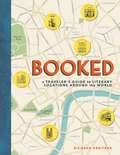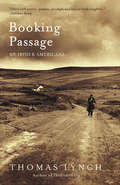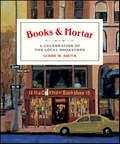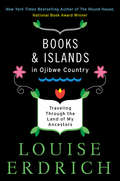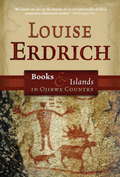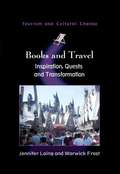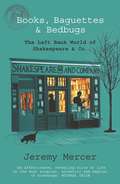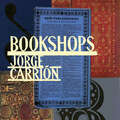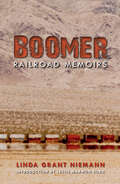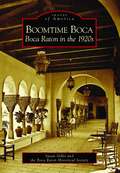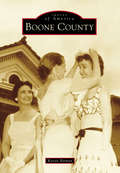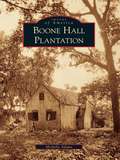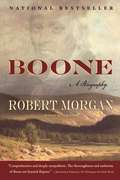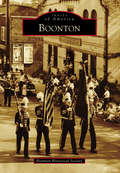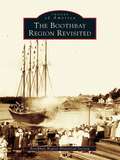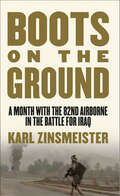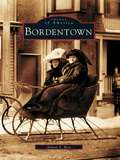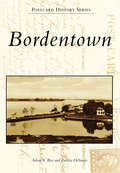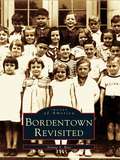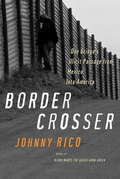- Table View
- List View
Booked: A Traveler's Guide to Literary Locations Around the World
by Richard KreitnerA practical, armchair travel guide that explores eighty of the most iconic literary locations from all over the globe that you can actually visit. A must-have for every fan of literature, Booked inspires readers to follow in their favorite characters footsteps by visiting the real-life locations portrayed in beloved novels including the Monroeville, Alabama courthouse in To Kill a Mockingbird, Chatsworth House, the inspiration for Pemberley in Pride and Prejudice, and the Kyoto Bridge from Memoirs of a Geisha. The full-color photographs throughout reveal the settings readers have imagined again and again in their favorite books. Organized by regions all around the world, author Richard Kreitner explains the importance of each literary landmark including the connection to the author and novel, cultural significance, historical information, and little-known facts about the location. He also includes travel advice like addresses and must-see spots. Booked features special sections on cities that inspired countless literary works like a round of locations in Brooklyn from Betty Smith's iconic A Tree Grows in Brooklyn to Jonathan Lethem's Motherless Brooklyn and a look at the New Orleans of Tennessee Williams and Anne Rice. Locations include: Central Park, NYC (The Catcher in the Rye, JD Salinger) Forks, Washington (Twilight, Stephanie Meyer) Prince Edward Island, Canada (Anne of Green Gables, Lucy Maud Montgomery) Kingston Penitentiary, Ontario (Alias Grace, Margaret Atwood) Holcomb, Kansas (In Cold Blood, Truman Capote) London, England (White Teeth, Zadie Smith) Paris, France (Hunchback of Notre Dame, Victor Hugo) Segovia, Spain, (For Whom the Bell Tolls, Ernest Hemingway) Kyoto, Japan (Memoirs of a Geisha, Arthur Golden)
Booking Passage: We Irish and Americans
by Thomas LynchIn thirty-five years and dozens of return trips to Ireland, Thomas Lynch has found a template for the larger world inside the small one, the planet in the local parish. Part memoir, part cultural study, Booking Passage is a brilliant, often comedic guidebook for those "fellow travelers, fellow pilgrims" making their way through the complexities of their own lives and times.
Books & Mortar: A Celebration of the Local Bookstore
by Gibbs M. SmithThe local bookstore, a place of wonder, refuge, and rejuvenation for book lovers the world over. Books & Mortar is a celebration of these literary strongholds. Sixty-eight oil paintings capture these storefronts at a moment in time, and pair the artwork with anecdotes about the shops and reflections on bookselling by many of the owners themselves. A delightful gift for an avid reader, an inspiration for any bookstore owner, Books & Mortar is the perfect keepsake for anyone’s personal library.
Books and Islands in Ojibwe Country
by Louise ErdrichFor more than three decades, Louise Erdrich has enthralled readers with dazzling novels that paint an evocative portrait of Native American life. <P><P>In Books and Islands in Ojibwe Country, Erdrich takes us on an illuminating tour through the terrain her ancestors have inhabited for centuries: the lakes and islands of southern Ontario. Summoning to life the Ojibwe's sacred spirits and songs, their language and sorrows, she considers the many ways in which her tribe--whose name derives from the word ozhibii'ige, "to write"--have influenced her. Her journey links ancient stone paintings with a magical island where a bookish recluse built an extraordinary library, and she reveals how both have transformed her. A blend of history, mythology, and memoir, Books and Islands in Ojibwe Country is an enchanting meditation on modern life, natural splendor, and the ancient spirituality and creativity of Erdrich's native homeland--a long, elemental tradition of storytelling that is in her blood.
Books and Islands in Ojibwe Country: Traveling Through the Land of My Ancestors
by Louise ErdrichFor more than twenty years Louise Erdrich has dazzled readers with the intricately wrought, deeply poetic novels which have won her a place among today's finest writers. Her nonfiction is equally eloquent, and this lovely memoir offers a vivid glimpse of the landscape, the people, and the long tradition of storytelling that give her work its magical, elemental force. <P><P> In a small boat like those her Native American ancestors have used for countless generations, she travels to Ojibwe home ground, the islands of Lake of the Woods in southern Ontario. Her only companions are her new baby and the baby's father, an Ojibwe spiritual leader, on a pilgrimage to the sacred rock paintings their people have venerated for centuries as mystical "teaching and dream guides," and where even today Ojibwe leave offerings of tobacco in token of their power. With these paintings as backdrop, Erdrich summons to life the Ojibwe's spirits and songs, their language and sorrows, and the tales that are in their blood, echoing through her own family's very contemporary American lives and shaping her vision of the wider world. <P><P>Thoughtful, moving, and wonderfully well observed, her meditation evokes ancient wisdom, modern ways, and the universal human concerns we all share. "This book is a treasure and a delight. "-Minneapolis Star Tribune
Books and Travel
by Warwick Frost Jennifer LaingThe books that we read, whether travel-focused or not, may influence the way in which we understand the process or experience of travel. This multidisciplinary work provides a critical analysis of the inspirational and transformational role that books play in travel imaginings. Does reading a book encourage us to think of travel as exotic, adventurous, transformative, dangerous or educative? Do different genres of books influence a reader's view of travel in multifarious ways? These questions are explored through a literary analysis of an eclectic selection of books spanning the period from the eighteenth century to the present day. Genres covered include historical fiction, children's books, westerns, science-fiction and crime fiction.
Books, Baguettes and Bedbugs: Enchanting memoir of a struggling writer and an eccentric Paris bookshop
by Jeremy MercerEnchanting memoir of a struggling writer living and working in the eccentric Parisian bookshop, 'Shakespeare and Company''Completely riveting ...a vivid picture of modern Paris' OBSERVER'Shakespeare and Company' in Paris is one of the world's most famous bookshops. The original store opened in 1921 and became known as the haunt of literary greats, such as Ernest Hemingway, F. Scott Fitzgerald, George Bernard Shaw, Ezra Pound, Gertrude Stein and James Joyce.Sadly the shop was forced to close in 1941, but that was not the end of 'Shakespeare and Company'... In 1951 another bookshop, with a similar free-thinking ethos, opened on the Left Bank. Called 'Le Mistral', it had beds for those of a literary mindset who found themselves down on their luck and, in 1964, it resurrected the name 'Shakespeare and Company' and became the principal meeting place for Beatnik poets, such as Allen Ginsberg and William S. Burroughs, through to Henry Miller and Lawrence Durrell.Today the tradition continues and writers still find their way to this bizarre establishment, one of them being Jeremy Mercer. With no friends, no job, no money and no prospects, the thrill of escape from his life in Canada soon palls but, by chance, he happens upon the fairytale world of 'Shakespeare and Co' and is taken in.What follows is his tale of his time there, the curious people who came and went, the realities of being down and out in the 'city of light' and, in particular, his relationship with the beguiling octogenarian owner, George.
Bookshops
by Jorge Carrión"A lot of people will be interested in the famous bookshops of the world: Jorge Carrión has gone and visited them all. We can't travel right now, but we can travel in books." MARGARET ATWOODWhy do bookshops matter? How do they filter our ideas and literature? In this inventive and highly entertaining extended essay, Jorge Carrion takes his reader on a journey around the world, via its bookshops. His travels take him to Shakespeare & Co in Paris, Wells in Winchester, Green Apple Books in San Francisco, Librairie des Colonnes in Tangier, the Strand Book Store in New York and provoke encounters with thinkers, poets, dreamers, revolutionaries and readers. Bookshops is the travelogue of a lucid and curious observer, filled with anecdotes and stories from the universe of writing, publishing and selling books. A bookshop in Carrion's eyes never just a place for material transaction; it is a meeting place for people and their ideas, a setting for world changing encounters, a space that can transform lives.Written in the midst of a worldwide recession, Bookshops examines the role of these spaces in today's evershifting climate of globalisation, vanishing high streets, e-readers and Amazon. But far from taking a pessimistic view of the future of the physical bookshop, Carrion makes a compelling case for hope, underlining the importance of these places and the magic that can happen there. A vital manifesto for the future of the traditional bookshop, and a delight for all who love them.Translated from the Spanish by Peter Bush
Bookshops
by Jorge CarriónWhy do bookshops matter? How do they filter our ideas and literature? In this inventive and highly entertaining extended essay, Jorge Carrion takes his reader on a journey around the world, via its bookshops. His travels take him to Shakespeare & Co in Paris, Wells in Winchester, Green Apple Books in San Francisco, Librairie des Colonnes in Tangier, the Strand Book Store in New York and provoke encounters with thinkers, poets, dreamers, revolutionaries and readers. Bookshops is the travelogue of a lucid and curious observer, filled with anecdotes and stories from the universe of writing, publishing and selling books. A bookshop in Carrion's eyes never just a place for material transaction; it is a meeting place for people and their ideas, a setting for world changing encounters, a space that can transform lives.Written in the midst of a worldwide recession, Bookshops examines the role of these spaces in today's evershifting climate of globalisation, vanishing high streets, e-readers and Amazon. But far from taking a pessimistic view of the future of the physical bookshop, Carrion makes a compelling case for hope, underlining the importance of these places and the magic that can happen there. A vital manifesto for the future of the traditional bookshop, and a delight for all who love them.(P)2016 WF Howes Ltd
Boomer: Railroad Memoirs (Railroads Past and Present)
by Linda Grant Niemann“A fascinating mix of fact, history, self-confession, self-accusation, and self-forgiveness—a diary of both emotional relationships and travel.” —PasatiempoThis classic account of self-discovery and railroad life describes Linda Grant Niemann’s travels as an itinerant brakeman on the Southern Pacific. Boomer combines travelogue, Wild West adventure, sexual memoir, and closely observed ethnography. A Berkeley Ph.D., Niemann turned her back on academia and set out to master the craft of railroad brakeman, beginning a journey of sexual and subcultural exploration and traveling down a path toward recovery from alcoholism. In honest, clean prose, Niemann treks off the beaten path and into the forgotten places along the rail lines, finding true American characters with colorful pasts—and her true self as well.“Ma[kes] the railroad experience come alive with all its grit, danger, romance, and general outrageousness . . . Possibly the finest book I’ve ever read about the actual experience of working on the railroad.” —Trains Magazine“Niemann has a taut, lyrically restrained but vividly descriptive style, with an observational vigilance befitting a brakeman’s mindset, and her narrative clips along like a boxcar rolling through the yard.” —Bloom Magazine“A remarkable adventure tale, the occupational odyssey of the Ph.D. in literature who immerses herself in blue-collar America.” —Library Journal
Boomerang: Travels In The New Third World
by Michael Lewis“Lewis shows again why he is the leading journalist of his generation.”—Kyle Smith, Forbes The tsunami of cheap credit that rolled across the planet between 2002 and 2008 was more than a simple financial phenomenon: it was temptation, offering entire societies the chance to reveal aspects of their characters they could not normally afford to indulge. Icelanders wanted to stop fishing and become investment bankers. The Greeks wanted to turn their country into a pinata stuffed with cash and allow as many citizens as possible to take a whack at it. The Germans wanted to be even more German; the Irish wanted to stop being Irish. Michael Lewis's investigation of bubbles beyond our shores is so brilliantly, sadly hilarious that it leads the American reader to a comfortable complacency: oh, those foolish foreigners. But when he turns a merciless eye on California and Washington, DC, we see that the narrative is a trap baited with humor, and we understand the reckoning that awaits the greatest and greediest of debtor nations.
Boomtime Boca: Boca Raton in the 1920s (Images of America)
by Susan Gillis Boca Raton Historical SocietyBoca Raton, Florida, was a tiny farming community onthe southeastern coast of Florida when the state's 1920s real estate boom grew into a national phenomenon. Investors and new residents were drawn to the state from all over the country, a time Floridians referred to as "the Boom." In April 1925, well-known Palm Beach society architect Addison Mizner revealed his plans for an ambitious newdevelopment in Boca Raton. The plans included a gigantic oceanfront hotel, elegant mansions, golf and polo grounds, and palm-lined boulevards. The popularity of Mizner's projects stimulated many similar developments within the region, increasing the population of the town from 100 to several hundred residents. By the fall of 1926, however, theFlorida land boom came to an end. Boca Raton returned, for the most part, to its small-town agricultural heritage by 1930. By the end of the 20th century, boomtime dreams were fully realized and Boca Raton became one of Florida's most prestigious addresses.
Boone
by Donna Akers WarmuthIt was the Old Buffalo Trail that led both Native Americans and Daniel Boone to the site of present-day Boone, North Carolina, at an elevation of 3,333 feet. Located among the scenic and cool mountains of the High Country, Boone was for a long time a seasonal hunting spot with only a few settled families. After the Civil War the community's population began growing, and in 1899, the tiny town of Boone included 150 residents. In the 1880s, the treacherous and steep Boone and Blowing Rock Turnpike began to bring commerce and visitors to the mountains. Although this remote town was an unlikely location for a school, Watauga Academy was established in 1899, and it would later become Appalachian State University, one of the top-ranked Southern public colleges.
Boone County (Images of America)
by Kassie RitmanBoone County, founded on April Fools' Day in 1830, is situated in the center of the state, abutting Indiana's capital, Indianapolis. The first settlers found swampy land overgrown with ancient hardwoods, riddled with rattlesnakes, and teeming with wetland creatures--most famously, frogs. Although life was challenging for the area's first settlers, most persevered. Many chided that Boone was not fit to be included as a part of the fledgling state of Indiana. They dubbed the newly platted area as the "State of Boone" to set it aside from the superior farmland and living conditions found elsewhere in Indiana. Boone County's first census counted 621 persons in 1830. Today, many of the original surnames remain prevalent among a population that exceeds 60,000 residents.
Boone County (Then and Now)
by Robert SchrageAs one of the fastest growing counties in the country, Boone County has come a long way since its founding in 1799. Communities such as Florence, Union, and Burlington have changed dramatically, but residents still remember the vibrant past. Others such as Rabbit Hash, Belleview, and Petersburg remain small towns with much of their historic charm. In Then & Now: Boone County, vintage images are compared to modern photographs to showcase an interesting history and a tremendous change. The neighborhoods examined in this volume make up the heart of the county.
Boone Hall Plantation (Images of America)
by Michelle AdamsIn 1681, Boone Hall Plantation began its long history in the Lowcountry. From the Boone family through the McRaes, the plantation's residents, black and white, all left a significant imprint upon the land as the plantation survived two wars and became the longest running brickyard in the area. As a center of tourism, Boone Hall embodies the romance of the South while providing the resources necessary to understand the network of lives that has inhabited the plantation for over 300 years. The plantation is tightly linked with the community and draws upon that relationship in its many educational programs. Numerous festivals are celebrated at the plantation, including the Strawberry Festival and Happy Jack's Pumpkin Patch, and many seek the unique landscape for their social gatherings. Through these relationships and events, Boone Hall will endure well into the future.
Boone: A Biography
by Robert MorganIt is the story of America, about the man who was the largest spirit of his time. Hunter, explorer, settler, he was a trailblazer and a revolutionary--an American icon for more than two hundred years. Born in 1734, Daniel Boone participated in the colonization of North America, the settling of the Middle Plain, the French and Indian War and the Revolutionary War, the election of his friend as the first president of the United States, the Louisiana Purchase, and the Westward Expansion.
Boonton (Images of America)
by Boonton Historical SocietyBoonton’s origins date back to 1747 with the forgotten village of Old Boonton, the remains of which now lie under the Jersey City Reservoir. Distinguished for its iron forges and mills, Old Boonton owed its existence primarily to the waterpower provided by the Rockaway River. The building of the Morris Canal in 1825, which bypassed Old Boonton and caused its decline, was the driving force in the development of the current town of Boonton 1.5 miles upriver. In 1830, the New Jersey Iron Company selected this site for a new ironworks and imported machinery and workers from England, who brought with them their families and religions. Soon, homes, churches, and schools were built, and a town developed. As the years passed, Boonton evolved from a single-industry town into what it is today, an established community with an abundance of park lands, historic homes, and a thriving main street business district.
Boothbay Region Revisited, The
by Boothbay Region Historical SocietyThe Boothbay Region Revisited is a collection of vintage photographs illustrating the Yankee tenacity of those who settled this historic coastal area. Images ranging from the 1880s to the late 1900s depict the beautiful backdrop of Boothbay and Boothbay Harbor and the activities that have taken place there: shipbuilding and seafaring, small-town commerce and recreation, and the rise and expansion of the region as a summer resort.
Boots on the Ground: A Month with the 82nd Airborne in the Battle for Iraq
by Karl ZinsmeisterKarl Zinsmeister's Boots on the Ground includes 32 color photographs taken by the author during the month he was embedded with the 82nd in Kuwait and Iraq.This is a riveting account of the war in Iraq moving north with the 82nd Airborne. Units of the 82nd depart Kuwait and convoy to Iraq's Tallil Air Base en route to night-and-day battles within the major city of Samawah and its intact bridges across the Euphrates. Boots on the Ground quickly becomes an action-filled microcosm of the new kinds of ultramodern war fighting showcased in the overall battle for Iraq. At the same time it remains specific to the daily travails of the soldiers. Karl Zinsmeister, a frontline reporter who traveled with the 82nd, vividly conveys the careful planning and technical wizardry that go into today's warfare, even local firefights, and he brings to life the constant air-ground interactions that are the great innovation of modern precision combat.What exactly does it feel like to travel with a spirited body of fighting men? To come under fire? To cope with the battlefield stresses of sleep-deprivation, and a steady diet of field rations for weeks on end? Readers of this day-to-day diary are left with not only a flashing sequence of strong mental images, but also a notion of the sounds and smells and physical sensations that make modern military action unforgettable. Ultimately, Boots on the Ground is a human story: a moving portrayal of the powerful bonds of affection, trust, fear, and dedication that bind real soldiers involved in battle. There are unexpected elements: The humor that bubbles up amidst dangerous fighting. The pathos of a badly wounded young boy. The affection openly exhibited by many American soldiers--love of country, love of family and hometown, love of each other. This is a true-life tale of superbly trained men in extraordinary circumstances, packed with concrete detail, often surpassing fiction for sheer drama.
Booze Cruise: A Tour of the World's Essential Mixed Drinks
by André DarlingtonGo on a tour of the world's top cocktail destinations, featuring insider info and food-and-drink recipes that will add thrilling new flavors and global flair to your everyday life.World traveler and drinks writer André Darlington will be your tour guide through more than forty of the globe's most vibrant cocktail locales. Each city stop is packed with insider intel on the current scene, local history, easy food-and-drink recipes, and tasting notes. This sloshy voyage includes: Amsterdam, Dublin, London, Madrid, Stockholm, Cape Town, Tangier, Delhi, Singapore, Beirut, Tokyo, Bogotá, Havana, New Orleans, São Paulo, Toronto, Sydney, and many more!
Bordentown
by Arlene S. BiceOriginally known as Farnsworth's Landing, Bordentown was settled in 1682 by Quaker Thomas Farnsworth. A natural hub of transportation for its key location on the Delaware River between Philadelphia and New York City, Bordentown flourished in the nineteenth and twentieth centuries. Internationally known artists, writers, and inventors called Bordentown home; industry thrived; and many private schools, including Bordentown Military Institute, were highly rated. As residents do today, the people of early Bordentown took great pride in their city. With some two hundred vintage photographs, Bordentown explores the city and its fascinating people from the mid-1800s to the mid-1900s. Thomas Paine, the father of the American Revolution, considered Bordentown his home, as did Francis Hopkinson, designer of the American flag and signer of the Declaration of Independence. The John Bull steam engine was shipped from England and assembled in Bordentown by Isaac Dripps. Joseph Bonaparte, brother of Napoleon, lived happily at Point Breeze, his estate in Bordentown. These stories, along with many others, are portrayed by the well-preserved historical photographs and informative text of this volume.
Bordentown
by Arlene S. Bice Patricia DesantisBordentown, New Jersey, is located at the confluence of the Delaware River, Blacks Creek, and Crosswicks Creek. The town sits on a high bluff northeast of Philadelphia. Bordentown has always been an accessible crossroads, first by water and train and presently by car and light rail. The community was a railroading town and had a successful boating industry. It eventually transitioned into a factory town, supporting such businesses as Eagle Shirt Factory, Ocean Spray Cranberries, and Springfield Worsted Mills. Motels, drive-ins, and diners sprang up along the highway as halfway stops from northeast to southwest Jersey. The New Jersey Turnpike brought tourists and visitors, who frequented the locally owned restaurants, shops, and galleries. Bordentown showcases the rich industrial and community history of this Burlington County town.
Bordentown Revisited (Images of America)
by Arlene S. BiceBordentown Revisited highlights the memorable growth of an area located at the kink of the Delaware River. The city of Bordentown and neighboring Fieldsboro share a stretch ofriverfront, and that waterfront location brought them great prosperity during the industrial years. The rural township traded its agricultural occupation for housing development. Then, as old paths and byways became streets and highways, businesses, motels, and restaurants emerged along the roadside.
Border Crosser: One Gringo's Illicit Passage from Mexico into America
by Johnny RicoFrom the author of the cult hit "Blood Makes the Grass Grow Green" comes another riveting book of immersion journalism that explores the violent, poignant, and darkly comic world of illegal immigration.
